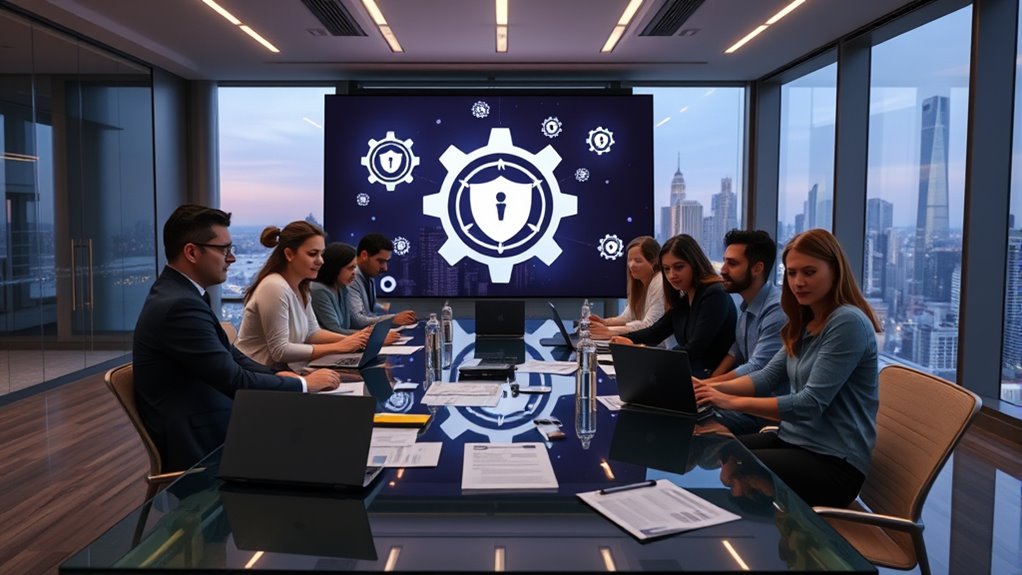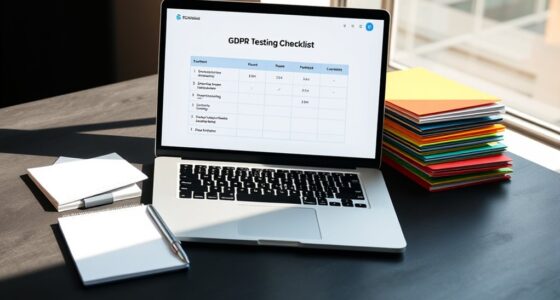Integrating automated compliance checks into your DevSecOps pipeline guarantees continuous adherence to regulatory standards without slowing down development. By automating audits, you get instant feedback on compliance status, enabling quick fixes and ongoing audit readiness. This proactive approach helps you adapt swiftly to evolving regulations and reduces manual effort. Embedding compliance into daily workflows fosters a security-first culture, making it easier to maintain standards. Keep exploring to discover how you can bridge the gap between DevSecOps and compliance seamlessly.
Key Takeaways
- Automated audits embed compliance checks into the CI/CD pipeline, ensuring continuous adherence without slowing development.
- Mapping regulatory standards to automation tools enables real-time validation of controls like GDPR, HIPAA, and PCI DSS.
- Continuous monitoring provides immediate feedback, reducing manual effort and facilitating swift remediation of compliance issues.
- Automated compliance fosters a proactive security culture, integrating regulatory adherence into daily DevSecOps practices.
- Timestamped, audit-ready reports streamline audit processes, maintaining ongoing compliance and stakeholder confidence.

As organizations increasingly adopt DevSecOps to accelerate development and improve security, integrating compliance into this fast-paced environment becomes essential. You need to verify that security and regulatory requirements are met without slowing down your development cycles. One effective way to do this is through automated audits, which continuously monitor your systems for compliance issues in real-time. Automated audits help you detect deviations from regulatory standards early, reducing the risk of costly violations and rework. By embedding these audits into your CI/CD pipelines, you can automatically verify that your code, configurations, and infrastructure adhere to necessary compliance frameworks. This seamless integration allows you to maintain regulatory alignment without sacrificing speed, giving your team confidence that every deployment remains compliant.
Automated audits also serve as a proactive approach rather than a reactive one. Instead of waiting for manual checks or post-deployment reviews, these audits run automatically whenever changes are made. This means you get immediate feedback on compliance status, enabling swift remediation if issues arise. Over time, this continuous monitoring helps you build a culture of compliance, where adherence to regulations becomes part of your daily development process rather than an afterthought. Additionally, automated audits support audit readiness by providing detailed, timestamped reports that demonstrate compliance efforts to auditors or regulatory bodies, simplifying the audit process and reducing the burden of documentation. Ensuring ongoing compliance is crucial to adapt swiftly to evolving standards and maintain trust with stakeholders.
Automated audits provide real-time compliance feedback, fostering a proactive security culture and simplifying audit readiness.
To maximize the benefits of automated audits, you should align them with your regulatory frameworks from the start. This involves mapping your compliance requirements to your automation tools and processes. For example, if you’re working under GDPR, HIPAA, or PCI DSS, ensure your automated checks specifically target the controls mandated by these standards. This alignment not only guarantees regulatory adherence but also streamlines your overall security posture, making it easier to adapt to changing regulations or new standards as they emerge. When your automated audits are tightly integrated with your compliance goals, you create a resilient DevSecOps pipeline that balances rapid delivery with rigorous regulatory alignment.
In essence, automating compliance checks transforms how you manage security and regulatory requirements in a DevSecOps environment. You gain real-time visibility into your compliance health, reduce manual effort, and foster a proactive security culture. By focusing on automated audits and ensuring regulatory alignment from the outset, you position your organization to innovate faster while confidently meeting all necessary standards. This approach empowers you to stay ahead of compliance challenges and deliver secure, compliant software at the speed your business demands.
Frequently Asked Questions
How Can Organizations Measure Devsecops Compliance Effectiveness?
You can measure your DevSecOps compliance effectiveness by conducting regular risk assessments to identify vulnerabilities and track improvements. Use compliance metrics like automated scan results, response times, and audit scores to monitor progress. These tools help you understand how well security practices are integrated into your development process. Consistently reviewing these metrics guarantees you stay aligned with compliance standards and enhance your overall security posture.
What Tools Integrate Security and Compliance Seamlessly in Devsecops?
Did you know 60% of organizations struggle with integrating security and compliance? To address this, you should look for tools that offer automated testing and policy enforcement seamlessly within your DevSecOps pipeline. These tools help guarantee consistent security checks, enforce policies automatically, and reduce manual errors. By choosing the right solutions, you can streamline compliance efforts, improve security posture, and accelerate your development lifecycle effectively.
How Does Devsecops Impact Regulatory Audit Processes?
You’ll find that DevSecOps streamlines regulatory audit processes by embedding security and compliance into daily workflows. It enhances regulatory reporting accuracy and consistency, reducing manual effort. Automated audit processes enable quicker, more reliable audit automation, minimizing errors and speeding up reviews. As a result, you’ll experience smoother audits, better compliance tracking, and fewer surprises, making regulatory assessments more straightforward and less time-consuming.
What Are Common Challenges in Aligning Devsecops With Compliance Standards?
You’d think aligning DevSecOps with compliance standards would be straightforward, but irony strikes—you face security gaps that stubbornly resist policy enforcement. Common challenges include integrating security seamlessly without slowing development, maintaining real-time compliance, and ensuring everyone follows strict policies. It’s a balancing act where overlooked gaps can lead to vulnerabilities, making it seem like compliance is just an afterthought. Yet, without proper alignment, your security and regulatory goals remain out of reach.
How Can Teams Foster a Security-First Culture in Devsecops?
To foster a security-first culture in DevSecOps, you should prioritize security awareness by providing ongoing training and clear communication. Encourage your team to view security as a shared responsibility, integrating risk management into daily workflows. Empower everyone to identify and address vulnerabilities early, making security a natural part of development. This proactive approach builds trust, minimizes risks, and guarantees security remains at the forefront of your DevSecOps practices.
Conclusion
By integrating DevSecOps with compliance, you can reduce security breaches by up to 50% and accelerate your development cycles. Embracing this approach not only guarantees you meet regulatory standards but also boosts your team’s agility. Remember, over 70% of organizations that adopt DevSecOps report improved security posture. So, bridge the divide today, and turn compliance into a competitive advantage—making your workflows safer, faster, and more efficient.









